|
|

|
Porsche, and the Porsche crest are registered trademarks of Dr. Ing. h.c. F. Porsche AG.
This site is not affiliated with Porsche in any way. Its only purpose is to provide an online forum for car enthusiasts. All other trademarks are property of their respective owners. |
|
|
  |
| 76-914 |
 Dec 6 2018, 01:52 PM Dec 6 2018, 01:52 PM
Post
#41
|
|
Repeat Offender & Resident Subaru Antagonist           Group: Members Posts: 13,634 Joined: 23-January 09 From: Temecula, CA Member No.: 9,964 Region Association: Southern California 
|
Once on the rotisserie the dolly frame really keeps the chassis rigid. I took the door braces out to test it and there was no change in the door gaps, even when rotating. I put the door braces back in anyway to help when I get to welding in the firewall etc. Here is a picture of it when I pulled it out o the garage to do some spot sandblasting. Like that fixture. (IMG:style_emoticons/default/beerchug.gif) Did the Merc survive it's intro to that IH? Those old IH'S were built like a Bomb Shelter! |
| amfab |
 Dec 6 2018, 01:53 PM Dec 6 2018, 01:53 PM
Post
#42
|
|
Member   Group: Members Posts: 401 Joined: 17-May 16 From: Los Angeles Member No.: 20,004 Region Association: None 
|
This one comes not from the P.O.—just from rust. The 2 lines from the charcoal canister and antenna cable hole.
Rust: 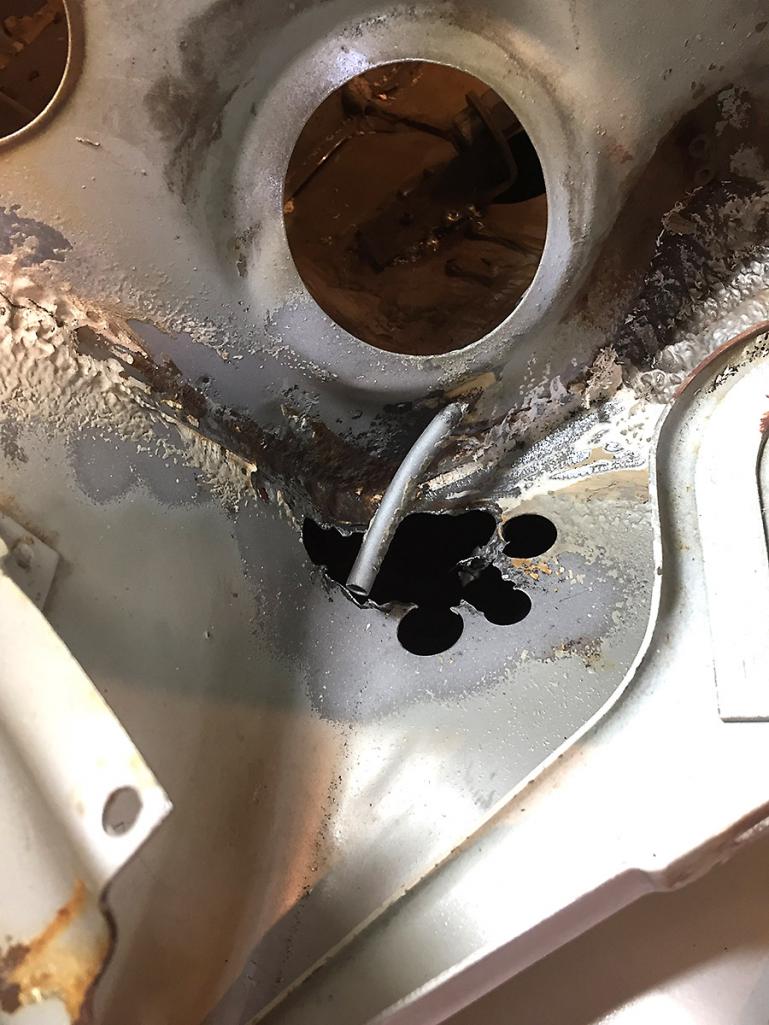 I sectioned this in from some sheetmetal I cut from part of a front clip from a 1974 that Oscar Vellios gave me. It didn't have the gas line holes, but it had the dimples to drill them. Did they not put those gas lines on all models in 1974? My Car is a 1974 and had the three holes. The one from Oscar only had the one hole and two dimples. 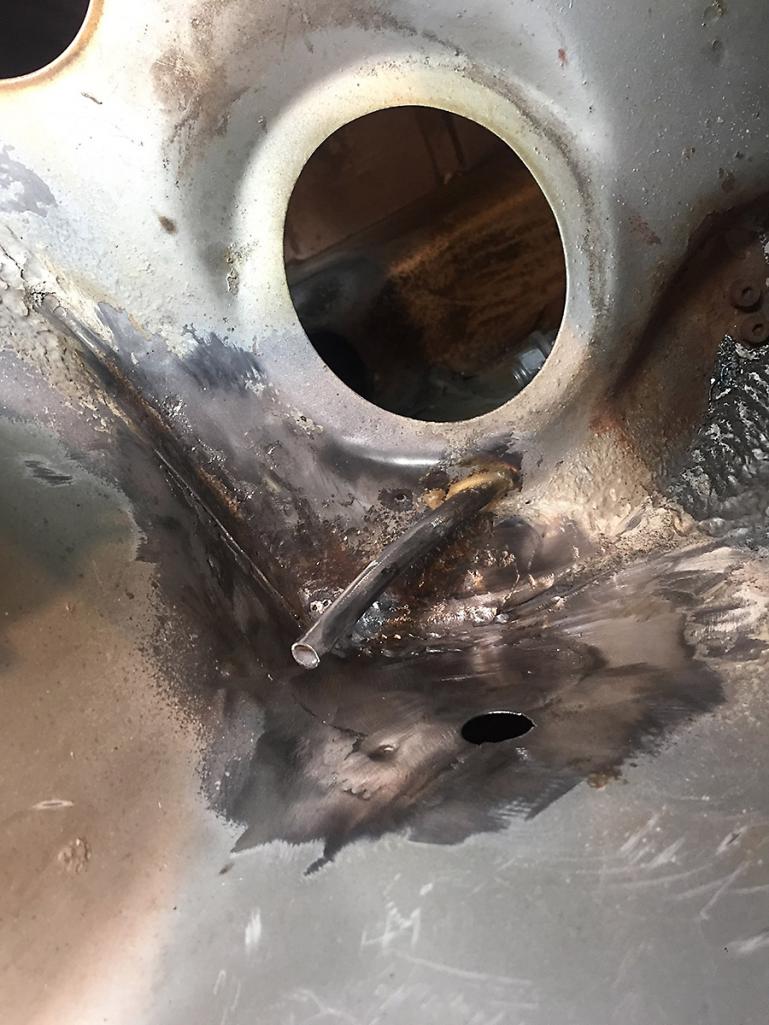 Inside the wheel well: 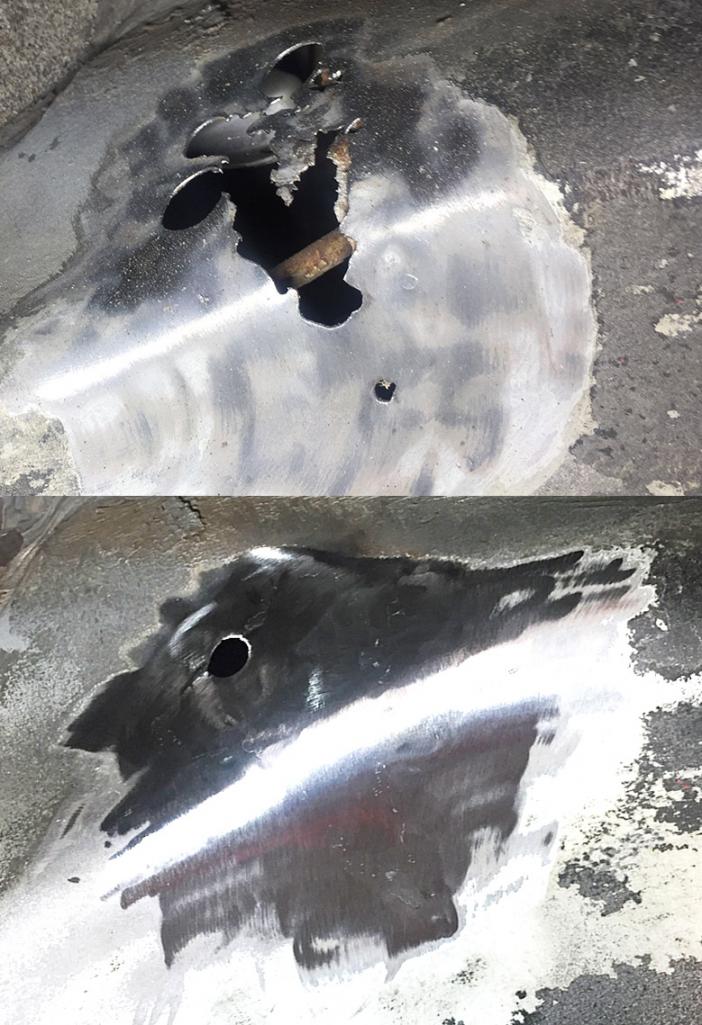 |
| amfab |
 Dec 6 2018, 02:00 PM Dec 6 2018, 02:00 PM
Post
#43
|
|
Member   Group: Members Posts: 401 Joined: 17-May 16 From: Los Angeles Member No.: 20,004 Region Association: None 
|
QUOTE Did the Merc survive it's intro to that IH? Those old IH'S were built like a Bomb Shelter! I was going about 15 mph and and a brand new—no tags yet—2018 GLE suv pulled out from parking on the side of the street right into me, I tried to swerve but the the IH doesn't do "swerve" very well—even as he hit me the IH didn't move much. The impact trashed the front of his car. Both wheels were pointed toward the center of the car and it was un-drivable. I got insurance info and chugged away. |
| amfab |
 Dec 6 2018, 04:24 PM Dec 6 2018, 04:24 PM
Post
#44
|
|
Member   Group: Members Posts: 401 Joined: 17-May 16 From: Los Angeles Member No.: 20,004 Region Association: None 
|
Unfortunately, the Restoration design floor pan ends a little shy of an area that I think is rather rust prone—the recess right under the pedals. I had to get a piece to fit that as the rest of the pan where it starts to curve up towards the steering rack was ok. Fortunately the part from Oscar's partial clip fit.
I am patching back to where the new RD pan will start. 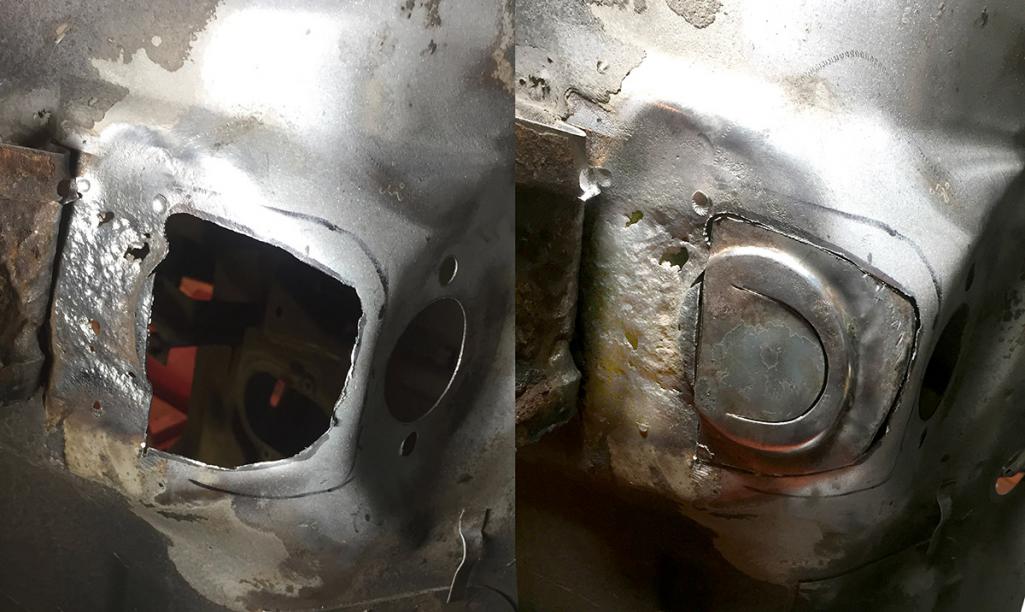 My thought right now is to keep the old rusty floor pan on the car and have the chassis professionally blasted, then replace the floor pan afterwards. This will help to keep the chassis straight while it is being transported to the blast/prime shop. Then when it comes back I can pull the old pan and weld in the new. I can spot sandblast and spot prime whatever rust gets exposed. This would include doing the inside of the center tunnel. Please give me any thoughts you guys have on the order? I have a decent sandblaster, but its not powerful enough to do the whole car. I want something to get ALL the seam sealer off so I can see any rot underneath. |
| dr914@autoatlanta.com |
 Dec 6 2018, 04:32 PM Dec 6 2018, 04:32 PM
Post
#45
|
|
914 Guru      Group: Members Posts: 8,101 Joined: 3-January 07 From: atlanta georgia Member No.: 7,418 Region Association: None |
congrats on saving the car, we just did one that was very similar but the floor pans were good. Thankfully we had made all of the rust repair panels years ago so were able to save many many 914s
OK, well I had to have a thread title. I am calling it that because it will restore structural integrity to the car and I want to be able to say that the rust has been correctly repaired if I eventually sell the car, unlike the lack of integrity of the person who hid the rust to sell it. Pictures below The floor is a little shiny because there is still some mineral spirits on it from trying to get the tar off. The open areas that you are seeing are after I wire brushed with knotted wire wheels on a grinder, then a carbide burr on a die grinder. While I will take some more off, what you see is getting close to good weldable metal. First the longs: The driver’s side is the worst. The bottom edges inside and out were full of holes, or very thin, so I cut the outside of the driver’s all the way off—except I haven’t got to the front under the door pillar yet. I have cut out about 30 percent of the passenger’s side. The middle section is solid but I will replace it anyway. I started getting a little scared to take more out until I brace up the body. The floor pan: There are lots of sloppy welded patches and holes around the seams. The rear passenger’s and rear drivers quarters of the floor pan have been replaced with some plain steel—blue for some reason. The PO welded a solid bar on each side to mount the seat hinges. Sloppy, unground welds abound. There are some rust-through spots at the front of the pan that will need patching, but overall the pan in front of the cross member is solid. Some patches in the lower firewall are solid. Measuring diagonally, window frame to targa bar and straight back window frame to targa bar it is off no more than 1/8 inch. This changes depending upon doors open or closed or movement of the jack stands. The door gaps were never problems—maybe the driver’s side was a little wide. So it seems the car is pretty within spec and adjustable doorframe bars should be able to pull—or push—things to be good Here is where I need advice. This is my plan, please give feedback: 1) Pull Wiring harness, speedometer cable and gas lines out of the center tunnel (What else is in there?) pull gas tank. 2) Pull doors and build adjustable bars to align doorframes 3) Continue to grind back to clean metal in the inside of the longs. Sandblast, then create internal angled patch pieces to repair the inner longitudinals from 18ga cold rolled. I am using michelko’s example see: http://www.914world.com/bbs2/index.php?s=&...st&p=219748 4) Cut off the majority of the inner rockers (The upper half or three quarters of the longs are very solid) and replace with inner rockers from Restoration Design. 5) Coat interiors of longs with Ospho then Eastwood frame coating 6) Patch any inner long parts to the area aft of the Restoration Design patch with 18ga cold rolled steel. 7) Install Brad Mayuer reinforcement kit over the longs 8) Cut rear floor quarters and cross member out 9) Weld in new rear floor panel and cross member, grinding out old welds and creating flanges from18ga where necessary—in the spots where there is no flange left in spots along the firewall and inner long 10) Remove and rebuild pedal cluster and create patches for small rust spots in the front of the footwells. 11) Sandblast interior and prime and paint. 12) Cut holes for front sway bar, sand blast and prime and paint bottom of gas tank area. 13) Install gas tank, new stainless gas lines and reinstall wiring harness. Please give any feedback regarding my plan |
| amfab |
 Dec 6 2018, 04:47 PM Dec 6 2018, 04:47 PM
Post
#46
|
|
Member   Group: Members Posts: 401 Joined: 17-May 16 From: Los Angeles Member No.: 20,004 Region Association: None 
|
wow, when you repost the first page and I look at it, everything seems so simple...
|
| amfab |
 Dec 8 2018, 09:52 PM Dec 8 2018, 09:52 PM
Post
#47
|
|
Member   Group: Members Posts: 401 Joined: 17-May 16 From: Los Angeles Member No.: 20,004 Region Association: None 
|
Fantastic work. I absolutely LOVE that dolly-rotisserie hybrid!!! (IMG:style_emoticons/default/pray.gif) You asked if restoring this tub was the right or wrong thing? I'm 110% certain it was the RIGHT thing. (IMG:style_emoticons/default/smilie_pokal.gif) (IMG:style_emoticons/default/smilie_pokal.gif) Thanks Brent. Your project is an inspiration to me—helps me keep moving forward no matter how slowly |
| Tdskip |
 Dec 9 2018, 10:15 AM Dec 9 2018, 10:15 AM
Post
#48
|
|
Advanced Member     Group: Members Posts: 3,702 Joined: 1-December 17 From: soCal Member No.: 21,666 Region Association: None 
|
Great thread-I’m late to the party but thank you for documenting everything.
Can I ask what voltage and wire speed you’re using? No it will vary by welder etc., but I’m about to dive in and do some similar things and was hoping to get some experience on settings. Thanks! |
| amfab |
 Dec 9 2018, 11:28 AM Dec 9 2018, 11:28 AM
Post
#49
|
|
Member   Group: Members Posts: 401 Joined: 17-May 16 From: Los Angeles Member No.: 20,004 Region Association: None 
|
Great thread-I’m late to the party but thank you for documenting everything. Can I ask what voltage and wire speed you’re using? No it will vary by welder etc., but I’m about to dive in and do some similar things and was hoping to get some experience on settings. Thanks! I was using a Lincoln 125Plus—it is a 110V MIG welder. I tried .024 wire and .030. and started with the welder's recommended setting for 18 ga then tweaked from there. I found the spool mechanism that the Lincoln used would not give a steady wire speed sometimes due to spool weight and/or the rotation of the mechanism binding up the spool. I found the little 2lb spools were the worst, but the 10lb spools would also be problematic when they got down toward the end. I replaced the liner and lubed the wire and it would do well for a bit, then give inconsistent feed. It was very frustrating. In some instances the .024 wire had a little less burn through, but If you get the .030 dialed in it seems to work as well or sometimes even better. When I got to making the dolly and was welding on the heavy gauge tubing it was a bit under powered so I went and bought the Hobart MVP. I liked the option for 110v or 220v. I run it in the garage on 220v, but I wanted the portability of 110V. It does not have a continuously variable voltage—it is stepped. I was a little concerned about this when buying, but I find that changing the wire speed slightly gives me all the fine tuning I need. It is solidly consistent. I think that the drive wheels are designed to grip the wire well and help to isolate spool issues. I am really impressed with the welder, it may not be a high-end MIG, but for the money (under $800) I love it. Normally what I do is look at the chart inside the door of the welder at the recommended voltage/wire speed for 18 ga and 20 ga and play around between there until its woking well. Sometimes I will set it to 22 ga if Im getting burn through in odd instances and play with the wire speed a little. -Andrew Picts of the two welders. 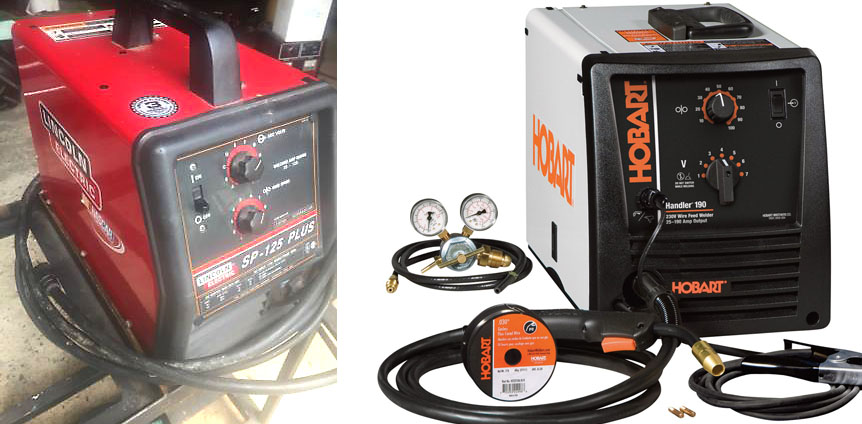 |
| Tdskip |
 Dec 9 2018, 12:40 PM Dec 9 2018, 12:40 PM
Post
#50
|
|
Advanced Member     Group: Members Posts: 3,702 Joined: 1-December 17 From: soCal Member No.: 21,666 Region Association: None 
|
Great thread-I’m late to the party but thank you for documenting everything. Can I ask what voltage and wire speed you’re using? No it will vary by welder etc., but I’m about to dive in and do some similar things and was hoping to get some experience on settings. Thanks! I was using a Lincoln 125Plus—it is a 110V MIG welder. I tried .024 wire and .030. and started with the welder's recommended setting for 18 ga then tweaked from there. I found the spool mechanism that the Lincoln used would not give a steady wire speed sometimes due to spool weight and/or the rotation of the mechanism binding up the spool. I found the little 2lb spools were the worst, but the 10lb spools would also be problematic when they got down toward the end. I replaced the liner and lubed the wire and it would do well for a bit, then give inconsistent feed. It was very frustrating. In some instances the .024 wire had a little less burn through, but If you get the .030 dialed in it seems to work as well or sometimes even better. When I got to making the dolly and was welding on the heavy gauge tubing it was a bit under powered so I went and bought the Hobart MVP. I liked the option for 110v or 220v. I run it in the garage on 220v, but I wanted the portability of 110V. It does not have a continuously variable voltage—it is stepped. I was a little concerned about this when buying, but I find that changing the wire speed slightly gives me all the fine tuning I need. It is solidly consistent. I think that the drive wheels are designed to grip the wire well and help to isolate spool issues. I am really impressed with the welder, it may not be a high-end MIG, but for the money (under $800) I love it. Normally what I do is look at the chart inside the door of the welder at the recommended voltage/wire speed for 18 ga and 20 ga and play around between there until its woking well. Sometimes I will set it to 22 ga if Im getting burn through in odd instances and play with the wire speed a little. -Andrew Picts of the two welders.  Very helpful, thank you. I have the same (or near identical Hobart). Good machine. Fortunately I will be doing localized floor patching etc which makes it a bit easier but still want to make sure it is tidy. |
| amfab |
 Dec 9 2018, 02:15 PM Dec 9 2018, 02:15 PM
Post
#51
|
|
Member   Group: Members Posts: 401 Joined: 17-May 16 From: Los Angeles Member No.: 20,004 Region Association: None 
|
Well I am swearing at it today, I have some thin spots in the wheel wells that Im running at 2 voltage and 20 wire speed which is what is says for 22G., I get to a thin spot and shine a light from behind and find a pin hole, and next thing I know I am chasing an opening as I keep burning a half an inch past it. then I go back and grind it smooth and find another pinhole.
What do people do just kept patching or just throw some filler on it? -Andrew |
| bbrock |
 Dec 9 2018, 02:54 PM Dec 9 2018, 02:54 PM
Post
#52
|
|
914 Guru      Group: Members Posts: 5,269 Joined: 17-February 17 From: Montana Member No.: 20,845 Region Association: Rocky Mountains 
|
Well I am swearing at it today, I have some thin spots in the wheel wells that Im running at 2 voltage and 20 wire speed which is what is says for 22G., I get to a thin spot and shine a light from behind and find a pin hole, and next thing I know I am chasing an opening as I keep burning a half an inch past it. then I go back and grind it smooth and find another pinhole. What do people do just kept patching or just throw some filler on it? -Andrew Are you using a copper backer? Helps a lot in those areas. But there have been times like this when I realize I need to start over with a larger patch that ties into healthy metal. |
| Tdskip |
 Dec 9 2018, 04:46 PM Dec 9 2018, 04:46 PM
Post
#53
|
|
Advanced Member     Group: Members Posts: 3,702 Joined: 1-December 17 From: soCal Member No.: 21,666 Region Association: None 
|
Well I am swearing at it today, I have some thin spots in the wheel wells that Im running at 2 voltage and 20 wire speed which is what is says for 22G., I get to a thin spot and shine a light from behind and find a pin hole, and next thing I know I am chasing an opening as I keep burning a half an inch past it. then I go back and grind it smooth and find another pinhole. What do people do just kept patching or just throw some filler on it? -Andrew Are you using a copper backer? Helps a lot in those areas. But there have been times like this when I realize I need to start over with a larger patch that ties into healthy metal. Agree - that was my take too. Tempting to just keep zapping it but better to cut a larger patch. |
| amfab |
 Dec 9 2018, 04:51 PM Dec 9 2018, 04:51 PM
Post
#54
|
|
Member   Group: Members Posts: 401 Joined: 17-May 16 From: Los Angeles Member No.: 20,004 Region Association: None 
|
yeah, I have a couple copper backing things. Still it can get frustrating.
I think its my grinding technique that needs work, not so much the welding. |
| bbrock |
 Dec 9 2018, 06:25 PM Dec 9 2018, 06:25 PM
Post
#55
|
|
914 Guru      Group: Members Posts: 5,269 Joined: 17-February 17 From: Montana Member No.: 20,845 Region Association: Rocky Mountains 
|
I feel your pain. Especially hard when you spent a couple hours carefully fitting in a patch. And yes, we tend to overlook the grinding, but I find getting that technique right is as challenging as the welding. You're doing great though! Still jealous of that Dollisserie. (IMG:style_emoticons/default/beerchug.gif)
|
| Tdskip |
 Dec 9 2018, 07:56 PM Dec 9 2018, 07:56 PM
Post
#56
|
|
Advanced Member     Group: Members Posts: 3,702 Joined: 1-December 17 From: soCal Member No.: 21,666 Region Association: None 
|
What do you use to grind? Flap wheel?
|
| bbrock |
 Dec 9 2018, 08:10 PM Dec 9 2018, 08:10 PM
Post
#57
|
|
914 Guru      Group: Members Posts: 5,269 Joined: 17-February 17 From: Montana Member No.: 20,845 Region Association: Rocky Mountains 
|
Flap wheel generates too much heat. Too easy to warp the metal after you were so careful keeping things cool during welding. I typically start with a cutting wheel mounted in a die grinder and used on edge (constantly moving) to take off the bulk of the weld but being careful not to touch the parent metal, or I take it down with a 2", 36g disc in an angle grinder depending on the weld, my mood, and which tool is handy. then switch to 80g 2" disc to take it down to the surface of the parent material. Finally, finish up with a conditioning disc. That said, I'm still very much a nube and things don't always go as planned. (IMG:style_emoticons/default/smile.gif) Lots' of good threads about grinding. McMark posted a nice video showing his technique http://www.914world.com/bbs2/index.php?showtopic=322374. |
| amfab |
 Dec 9 2018, 08:18 PM Dec 9 2018, 08:18 PM
Post
#58
|
|
Member   Group: Members Posts: 401 Joined: 17-May 16 From: Los Angeles Member No.: 20,004 Region Association: None 
|
Dollisserie I like that.
Maybe its my fondness for flap wheels that is causing me the problems. -Andrew |
| bbrock |
 Dec 9 2018, 08:55 PM Dec 9 2018, 08:55 PM
Post
#59
|
|
914 Guru      Group: Members Posts: 5,269 Joined: 17-February 17 From: Montana Member No.: 20,845 Region Association: Rocky Mountains 
|
Yeah, in addition to heat, they eat a lot of metal in a hurry. They are seductive because they quickly take an ugly weld and make it pretty, but there's a reason the pros don't use them much. I learned that the hard way.
|
| amfab |
 Dec 9 2018, 09:05 PM Dec 9 2018, 09:05 PM
Post
#60
|
|
Member   Group: Members Posts: 401 Joined: 17-May 16 From: Los Angeles Member No.: 20,004 Region Association: None 
|
Yeah, in addition to heat, they eat a lot of metal in a hurry. They are seductive because they quickly take an ugly weld and make it pretty, but there's a reason the pros don't use them much. I learned that the hard way. K, I will switch to regular disks and see if that helps me Thanks! |
  |
2 User(s) are reading this topic (2 Guests and 0 Anonymous Users)
0 Members:

|
Lo-Fi Version | Time is now: 22nd November 2024 - 06:32 PM |
Invision Power Board
v9.1.4 © 2024 IPS, Inc.









